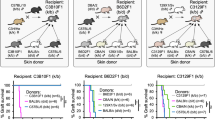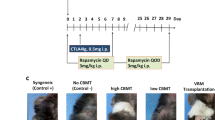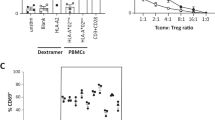Abstract
Solid organ transplants contain small numbers of leukocytes that can migrate into the host and establish long-lasting microchimerism. Although such microchimerism is often associated with graft acceptance and tolerance, it has been difficult to demonstrate a true causal link. Using skin from mutant mice deficient for leukocyte subsets, we found that donor T-cell chimerism is a 'double-edged sword' that can result in very different outcomes depending on the host's immunological maturity and the antigenic disparities involved. In immunologically mature hosts, chimerism resulted in immunity and stronger graft rejection. In immature hosts, it resulted in tolerance to the chimeric T cells, but not to graft antigens not expressed by the chimeric cells. Clinical efforts aimed at augmenting chimerism to induce tolerance must take into account the maturation state of host T cells, the type of chimerism produced by each organ and the antigenic disparities involved, lest the result be increased rejection rather than tolerance.
This is a preview of subscription content, access via your institution
Access options
Subscribe to this journal
Receive 12 print issues and online access
$209.00 per year
only $17.42 per issue
Buy this article
- Purchase on Springer Link
- Instant access to full article PDF
Prices may be subject to local taxes which are calculated during checkout





Similar content being viewed by others
References
Snell, G.D. The homograft reaction. Annu. Rev. Microbiol. 11, 439–458 (1957)
Lafferty, K.J., Prowse, S.J., Simeonovic, C.J. & Warren, H.S. Immunobiology of tissue transplantation: a return to the passenger leukocyte concept. Annu. Rev. Immunol. 1, 143–173 (1983).
Donohoe, J.A. et al. Cultured thyroid allografts induce a state of partial tolerance in adult recipient mice. Transplantation 35, 62–67 (1983).
Thomson, A.W. et al. Microchimerism, dendritic cell progenitors and transplantation tolerance. Stem Cells 13, 622–639 (1995).
Starzl, T.E. et al. Cell migration, chimerism and graft acceptance. Lancet 339, 1579–158 (1992).
Starzl, T.E. et al. Donor cell chimerism permitted by immunosuppressive drugs: a new view of organ transplantation. Immunol. Today 14, 326–332 (1993).
Demetris, A.J. et al. Hematolymphoid cell trafficking, microchimerism, and GVH reactions after liver, bone marrow, and heart transplantation. Transplant. Proc. 25, 3337–3344 (1993).
Murase, N. et al. Variable chimerism, graft-versus-host disease, and tolerance after different kinds of cell and whole organ transplantation from Lewis to brown Norway rats. Transplantation 60, 158–171 (1995).
Ko, S. et al. The functional relevance of passenger leukocytes and microchimerism for heart allograft acceptance in the rat. Nature Med 5, 1292–1297 (1999).
Sun, J., McCaughan, G.W., Gallagher, N.D., Sheil, A.G. & Bishop, G.A. Deletion of spontaneous rat liver allograft acceptance by donor irradiation. Transplantation 60, 233–236 (1995).
Sriwatanawongsa, V., Davies, H.S. & Calne, R.Y. The essential roles of parenchymal tissues and passenger leukocytes in the tolerance induced by liver grafting in rats. Nature Med. 1, 428–432 (1995).
Michie, S.A., Kirkpatrick, E.A. & Rouse, R.V. Rare peripheral T cells migrate to and persist in normal mouse thymus. J. Exp. Med. 168, 1929–1934 (1988).
Shimonkevitz, R.P. & Bevan, M.J. Split tolerance induced by the intrathymic adoptive transfer of thymocyte stem cells. J. Exp. Med. 168, 143–156 (1988).
Matzinger, P. & Guerder, S. Does T-cell tolerance require a dedicated antigen-presenting cell? Nature 338, 74–76 (1989).
Ridge, J.P., Di Rosa, F. & Matzinger, P. A conditioned dendritic cell can be a temporal bridge between a CD4+ T-helper and a T-killer cell. Nature 393, 474–478 (1998).
Rammensee, H.G. & Hugin, D. Masking of veto function in vivo by activated CD4+ T lymphocytes. Eur. J. Immunol. 19, 643–648 (1989).
Zhang, L.I., Martin, D.R., Fung-Leung, W.P., Teh, H.S. & Miller, R.G. Peripheral deletion of mature CD8+ antigen-specific T cells after in vivo exposure to male antigen. J. Immunol. 148, 3740–3745 (1992).
Bonomo, A. & Matzinger, P. Thymus epithelium induces tissue-specific tolerance. J. Exp. Med. 177, 1153–1164 (1993).
Jhaver, K.G., Chandler, P., Simpson, E. & Mellor, A.L. Thymocyte antigens Do not induce tolerance in the CD4+ T cell compartment. J. Immunol. 163, 4851–4858 (1999).
Rosenberg, A.S., Mizuochi, T., Sharrow, S.O. & Singer, A. Phenotype, specificity, and function of T cell subsets and T cell interactions involved in skin allograft rejection. J. Exp. Med. 165, 1296–1315 (1987).
Wise, M. et al. CD4 T cells can reject major histocompatibility complex class I-incompatible skin grafts. Eur. J. Immunol. 29, 156–167 (1999).
Zhang, L. & Miller, R.G. The correlation of prolonged survival of maternal skin grafts with the presence of naturally transferred maternal T cells. J. Immunol. 56, 918–921 (1993).
Zijenah, L. et al. Mortality in the first 2 years among infants born to human immunodeficiency virus-infected women in Harare, Zimbabwe. J. Infect. Dis. 178, 109–113 (1998).
Zhang, L. et al. Role of infused CD8+ cells in the induction of peripheral tolerance. J. Immunol. 152, 2222–2228 (1997).
Gallucci, S., Lolkema, M. & Matzinger, P. Natural adjuvants: endogenous activators of dendritic cells. Nature Med. 5, 1249–1255 (1999).
Wood, K.J. Alternative approaches for the induction of transplantation tolerance. Immunol. Lett. 29, 133–137 (1991).
Thomas, J.M. et al. Preclinical studies of allograft tolerance in rhesus monkeys: a novel anti-CD3-immunotoxin given peritransplant with donor bone marrow induces operational tolerance to kidney allografts. Transplantation 64, 124–135 (1997).
de Vries-van der Zwan, A., Besseling, A.C., de Waal, L.P. & Boog, C.J. Specific tolerance induction and transplantation: a single-day protocol. Blood 89, 2596–2601 (1997).
Ridge, J.P., Fuchs, E.J. & Matzinger, P. Neonatal tolerance revisited: turning on newborn T cells with dendritic cells. Science 271, 1723–1726 (1996).
Wekerle, T. et al. Allogeneic bone marrow transplantation with co-stimulatory blockade induces macrochimerism and tolerance without cytoreductive host treatment. Nature Med. 6, 464–469 (2000).
Morita, H. et al. A strategy for organ allografts without using immunosuppressants or irradiation. Proc. Natl. Acad. Sci. USA 95, 6947–6952 (1998).
Introna, M., Allavena, P., Spreafico, F. & Mantovani, A. Inhibition of human natural killer activity by cyclosporin A. Transplantation 31, 113–116 (1981).
Matzinger, P. Tolerance, danger, and the extended family. Annu. Rev. Immunol. 12, 991–1045 (1994).
Matzinger, P. An innate sense of danger. Semin. Immunol. 10, 399–415 (1998).
Zamoyska, R., Waldmann, H. & Matzinger, P. Peripheral tolerance mechanisms prevent the development of autoreactive T cells in chimeras grafted with two minor incompatible thymuses. Eur. J. Immunol. 19, 111–117 (1989).
Wise, M.P., Bemelman, F., Cobbold, S.P. & Waldmann, H. Linked suppression of skin graft rejection can operate through indirect recognition. J. Immunol. 161, 5813–5816 (1998).
Waldmann, H. & Cobbold, S. How do monoclonal antibodies induce tolerance? A role for infectious tolerance? Annu. Rev. Immunol. 16, 619–644 (1998).
McCullagh, P. Inability of fetal skin to induce allograft tolerance in fetal lambs. Immunology 67, 489–495 (1989).
Schlitt, H.J., Hundrieser, J., Ringe, B. & Pichlmayr, R. Donor-type microchimerism associated with graft rejection eight years after liver transplantation. N. Engl. J. Med. 330, 646–647 (1994).
Alard, P., Matriano, J.A., Socarras, S., Ortega, M.A. & Streilein, J.W. Detection of donor-derived cells by polymerase chain reaction in neonatally tolerant mice. Microchimerism fails to predict tolerance. Transplantation 60, 1125–1130 (1995).
Qian, S. et al. Murine liver allograft transplantation: tolerance and donor cell chimerism. Hepatology 19, 916–924 (1994).
Pearson, T.C. et al. CTLA4-Ig plus bone marrow induces long-term allograft survival and donor specific unresponsiveness in the murine model. Evidence for hematopoietic chimerism. Transplantation 61, 997–1004 (1996).
Cao, X. et al. Defective lymphoid development in mice lacking expression of the common cytokine receptor gamma chain. Immunity 2, 223–238 (1995).
Teh, H.-S. et al. Thymic major histocompatibility complex antigens and the αβ T-cell receptor determine the CD4/CD8 phenotype of T-cells. Nature 335, 229–233 (1988).
Matzinger, P. The JAM Test. A simple assay for DNA fragmentation and cell death. J. Immunol. Meth. 145, 185–192 (1991).
Acknowledgements
We thank E. Bonney for assistance in thymus grafting, A. Bendelac, O. Lantz, J. Powell, A. Rosenberg, R. Schwartz and S. Gallucci for critical reading of the manuscript (and statistical analysis by O. Lantz), and members of the Ghost Lab (O. Alpan, S. Celli, S. Gallucci, K. Goldman, L. Graham, T. Kamala, R. Massey and J. Ridge) and the Laboratory of Cellular and Molecular Immunology for discussions.
Author information
Authors and Affiliations
Corresponding author
Rights and permissions
About this article
Cite this article
Anderson, C., Matzinger, P. Immunity or tolerance: Opposite outcomes of microchimerism from skin grafts. Nat Med 7, 80–87 (2001). https://doi.org/10.1038/83393
Received:
Accepted:
Issue Date:
DOI: https://doi.org/10.1038/83393
This article is cited by
-
Sex differences in Sjögren’s syndrome: a comprehensive review of immune mechanisms
Biology of Sex Differences (2015)
-
Dendritic cells and innate immunity in kidney transplantation
Kidney International (2015)
-
Subdominant H60 antigen-specific CD8 T-cell response precedes dominant H4 antigen-specific response during the initial phase of allogenic skin graft rejection
Experimental & Molecular Medicine (2015)
-
The sensory immune system: a neural twist to the antigenic discontinuity theory
Nature Reviews Immunology (2014)
-
The ability of natural tolerance to be applied to allogeneic tissue: determinants and limits
Biology Direct (2007)



